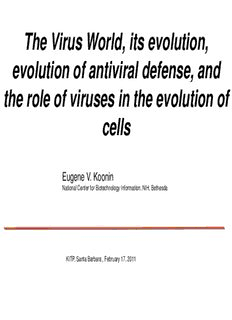
The Virus World, its evolution, evolution of antiviral defense PDF
Preview The Virus World, its evolution, evolution of antiviral defense
The Virus World, its evolution, evolution of antiviral defense, and the role of viruses in the evolution of cells Eugene V. Koonin National Center for Biotechnology Information, NIH, Bethesda KITP, Santa Barbara , February 17, 2011 What is a virus? A virus is a small infectious agent that can replicate only inside the living cells of organisms. http://en.wikipedia.org/wiki/Virus Viruses and virus-like agents possess: •genomes •very often –though not always – capsids that encase the genome but lack: •functional translation machinery •membranes with transport/secretion systems Raoult D, Forterre P. Redefining viruses: lessons from Mimivirus. Nat Rev Microbiol. 2008; 6(4):315-9 Viruses are the dominant entities in the biosphere – physically and genetically – as shown by viral metagenomics – virome studies 1 cm3 of seawater contains 106-109 virus particles Suttle, C.A. (2005) Nature 437:356 There are millions of diverse bacteriophage species in the water, soil, and gut Edwards and Rohwer (2005) Nat. Rev. Microbiol. 3:504 •Viruses are the most abundant biological entities in the biosphere: there are 10-100 virus particles per cell •The pangenomes of viruses and cellular organisms have [at least] comparable complexities Mean % of sequences with matches to major functional categories 15 Nucleosides and nucleotides Cell wall and capsule Fatty acids and lipids Membrane transport Key: Stress response s 10 e Carbohydrates Aromatic compound m o Amino acids Cell division and cell cycle n e g Virulence Nitrogen metabolism a et Protein metabolism Sulphur metabolism M Respiration Motility and chemotaxis al 5 r Vi Photosynthesis Phosphorus metabolism Cofactors, etc. Cell signalling RNA metabolism Potassium metabolism DNA metabolism Secondary metabolism 0 0 5 10 15 20 Microbial Metagenomes Most of the viromes might not even consists of typical viruses but rather of pseudovirus particles that carry microbial genes (GTAs) Kristensen, Mushegian, Dolja, Koonin Trends Microbiol 2010 Comparative genomics shows that viruses that cause human diseases belong to families that evolved hundreds of millions or even billions years ago: Viruses accompany the evolving cellular life throughout its history and might even predate it The largest, most complex viruses: NCLDV (Nucleo-Cytoplasmic Large DNA viruses of eukaryotes) – this is where the smallpox virus belongs Some vir uses are compar able to cellular life for ms in size and genetic complexity! Mimivirusgenome (~1.2 Mbp, ~1,000 genes) is twice as large as that of Mycoplasma genitalium(580 kbp; ~500 genes) Raoult et al. Science. 2004 Nov 19;306(5700):1344; Suzan-Monti et al. PLoS ONE. 2007 Mar 28;2(3) The largest, most complex viruses: the Nucleocytoplasmic Large DNA Viruses (NCLDV) (this is where the smallpox virus AND the mimivirus belong) 6 families of NCLDV…and counting # size, kb hosts -poxviridae 26 [134-360] vertebrates, insects -asfarviridae 1 [170] vertebrates, protists(?) -iridoviridae 8 [103-212] vertebrates, insects, protists(?) -ascoviridae 4 [119-174] insects -phycodnaviridae 9 [155-407] algae, haptophytes, stramenopiles -mimiviridae 2 [1181-1200] amoebozoa, algae(?) -[Marseille virus] 1 [368] amoebozoa – new family? Iyer, Aravind, Koonin, Common origin of four diverse families of large eukaryotic DNA viruses. J. Virol. 2001, 75: 11720 Iyer et al. Evolutionary genomics of nucleo-cytoplasmic large DNA viruses. Virus Res. 2006 Apr;117(1):156 The case for the monophyly (common origin) of NCLDV 9 universally conserved hallmark genes (vaccinia gene names): -primase (D5-N) -helicase (D5-C) -DNA polymerase (E9) -packaging ATPase (A32) -Major capsid protein (D13, non-capsid in poxviruses) -Thiol-oxidoreductase (E10) -Helicase (D6, D11) -S/T protein kinase (F10) -Transcription factor VLTF2 (A1) 47 genes mapped to the last common ancestor of NCLDV by maximum likelihood – all main functional systems represented Iyer et al. J. Virol. 2001; Virus Res. 2006; Yutin et al. Virol J. 2009 Phylogeny of NCLDV based on concatenation of 4 universal genes: primase- helicase, DNA polymerase, packaging ATPase, VLTF2 transcription factor Boyer, Yutin et al PNAS 2009 10000 b1 Helvi Koonin, Yutin, Intervirology 10000 b1 Spofr HOST 9315 b1 Trini 2010 9970 l2 Invir Ascoviridae Animals l1 Aedta & 10000 10000 l3 Lymch + diverse l3 Lymdi Iridoviridae 6702 10000 l5 Ambti protists 7557 9983 10000 l5 Frovi l5 Singr l4 Infsp Marseillevirus Amoebozoa, m6 Marseillevirus 10000 10000 n1 Acapo Mimiviridae n2 Mamav Algae, animals(?) q1 Acatu 10000 10000 q1 ParFR 10000 q1 ParMT Chlorophytes, 6735 9993 q1 ParAR 9910 10000 q1 ParNY Haptophytes, Phycodnaviridae q1 Parbu 7074 q6 Ostvi stramenopiles 10000 10000 q3 Ectsi q3 Felsp •Divergence of NCLDV q2 Emihu 10000 u2 Amsmo most likely antedates u2 Melsa 10000 u1 Bovpa divergence of eukaryotic u1 Orfvi 7417 u1 Deevi supergroups 4747 u1 Swivi •Alternative/addition: extensive 10000 u1 Myxvi 9720 9840 u1 Rabfi horizontal transfer of viruses 10000 4540u1 Goavi 10000 u1 Lumsk Animals 10000 Poxviridae u1 Shevi 9911 10000 u1 Tanvi 1000010000 u1 Yabli u1 Yabmo 5452 10000 u1 Vacvi u1 Varvi 10000 u1 Molco u1 Crovi Animals, 9871 u1 Canvi u1 Fowvi haptophytes c1 Afrsw Asfarviridae 0.5
Description: